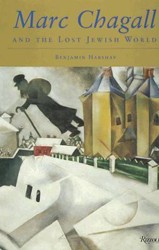By
– November 15, 2011
For the reader who knows Chagall only through his work, this book is a good introduction to the artist. Jonathan Wilson, a novelist and professor of English at Tufts University, provides a solid foundation for Chagall’s itinerant life and a broad appreciation of the artist’s achievement.
Born as Moishe Shagal in 1887 in the poor Jewish section of Vitebsk, a substantial town in Belarus, Chagall left the town as soon as he could to pursue his studies, but he never left Vitebsk emotionally. Wilson astutely points out that Chagall painted in Yiddish, the only language he comfortably spoke, literally translating the luftmensch— intellectual “airman” — and other fabulous creatures of Yiddish folklore into fanciful flying images.
Chagall first went to Paris in 1910 and settled there in 1923, absorbing the artistic energy and influences of the city and working furiously. Chagall’s professional and social world was the great stage of art — literature, theater, music — not the narrow world of East European Chasidism with which he is often identified. His dealer was Ambroise Vollard, who also represented Renoir, Picasso, Gauguin, Van Gogh. Chagall’s work sold well, and over his long life he gained commissions for churches, opera houses, ballets, synagogues from Chicago to Jerusalem to New York to Paris.
Wilson is strongest dealing with the tensions in Chagall’s life and work. He rescues Chagall from the sentimentality of Fiddler on the Roof and places his nostalgic, biblical, and folkloric inspiration in a universal setting. He explores Chagall’s conflicting personal and artistic identities: Fueled by Chasidism, Chagall lived a secular, politically engaged life; a painter of joy and luscious color, he frequently turned to the image of the crucified Jesus, sometimes wearing a tallit, to express the suffering of the period he lived through.
A volume in the Nextbook/Schocken Jewish Encounters series, Marc Chagall is not intended as a full-scale biography. Wilson does not discuss Chagall’s professional dealings or the origins and execution of his large-scale projects. Chagall’s emergence from poverty to wide recognition speeds by; a bibliographic note suggests further sources. But the reader’s greatest frustration is having to read about, not see, Chagall’s work, proving that one picture would indeed be worth a thousand words. An index would also have been helpful. Bibliographic note, chronology, and illustrations.
Born as Moishe Shagal in 1887 in the poor Jewish section of Vitebsk, a substantial town in Belarus, Chagall left the town as soon as he could to pursue his studies, but he never left Vitebsk emotionally. Wilson astutely points out that Chagall painted in Yiddish, the only language he comfortably spoke, literally translating the luftmensch— intellectual “airman” — and other fabulous creatures of Yiddish folklore into fanciful flying images.
Chagall first went to Paris in 1910 and settled there in 1923, absorbing the artistic energy and influences of the city and working furiously. Chagall’s professional and social world was the great stage of art — literature, theater, music — not the narrow world of East European Chasidism with which he is often identified. His dealer was Ambroise Vollard, who also represented Renoir, Picasso, Gauguin, Van Gogh. Chagall’s work sold well, and over his long life he gained commissions for churches, opera houses, ballets, synagogues from Chicago to Jerusalem to New York to Paris.
Wilson is strongest dealing with the tensions in Chagall’s life and work. He rescues Chagall from the sentimentality of Fiddler on the Roof and places his nostalgic, biblical, and folkloric inspiration in a universal setting. He explores Chagall’s conflicting personal and artistic identities: Fueled by Chasidism, Chagall lived a secular, politically engaged life; a painter of joy and luscious color, he frequently turned to the image of the crucified Jesus, sometimes wearing a tallit, to express the suffering of the period he lived through.
A volume in the Nextbook/Schocken Jewish Encounters series, Marc Chagall is not intended as a full-scale biography. Wilson does not discuss Chagall’s professional dealings or the origins and execution of his large-scale projects. Chagall’s emergence from poverty to wide recognition speeds by; a bibliographic note suggests further sources. But the reader’s greatest frustration is having to read about, not see, Chagall’s work, proving that one picture would indeed be worth a thousand words. An index would also have been helpful. Bibliographic note, chronology, and illustrations.
Maron L. Waxman, retired editorial director, special projects, at the American Museum of Natural History, was also an editorial director at HarperCollins and Book-of-the-Month Club.





